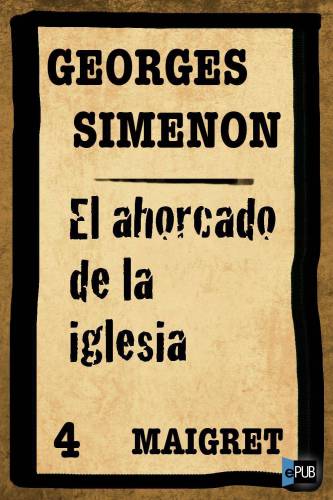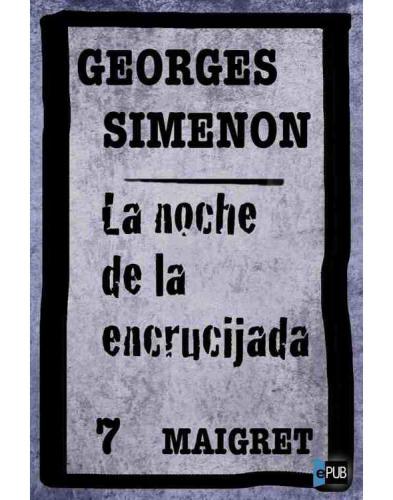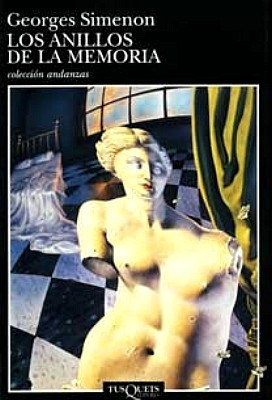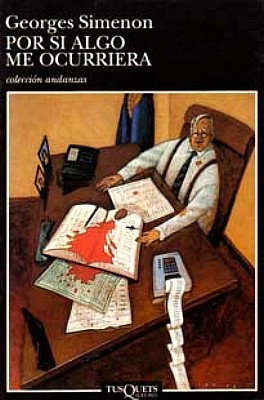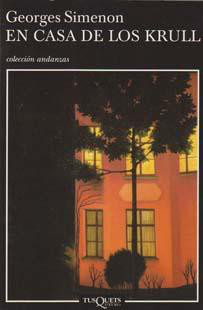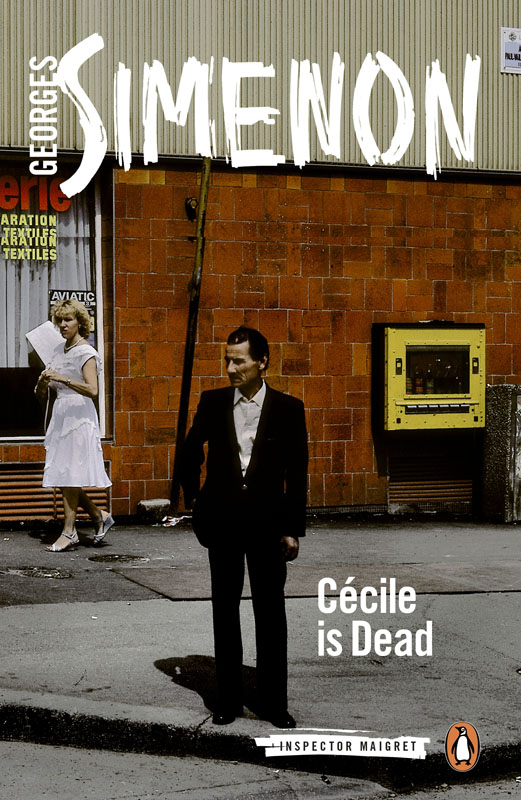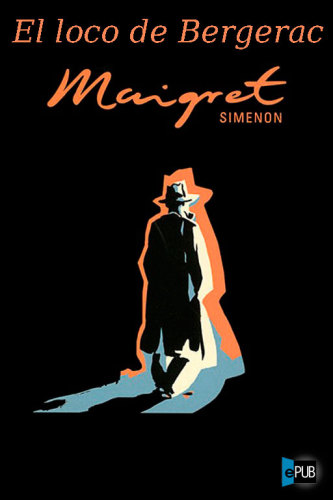oleebook.com
El hombre de Londres de Simenon, Georges
de Simenon, Georges - Género: Ficcion
Sinopsis
Simenon, Georges Year: 2009
Libros Recomendados - Relacionados
Reseñas Varias sobre este libro
GRIGIO FUMO
Dei quattro adattamenti cinematografici di questo romanzo, lultimo (2007) firmato dal regista ungherese Béla Tarr, è senzaltro il più interessante. Tarr, celebre per il suo Satantango (1994) di sette ore, è anche famoso per i suoi piano sequenza che certo non aiutano a rendere la durata delle sue opere più scorrevole lo stesso Luomo di Londra supera abbondantemente le due ore.
Anche questo uscito a puntate (ventitre!) come molti romanzi di Simenon, subito tradotto in Italia da Mondadori (stesso anno per la pubblicazione francese e italiana, 1934), è ambientato tra binari e porto come parecchie altre storie di GS, ha geografia di provincia, e anche questo aspetto è ricorrente nella sua letteratura.
Il perno della storia diventerà un classico di molta letteratura e anche molto cinema: un tizio che nulla centra trova per caso una valigia piena di denaro, la tiene e nasconde, spera di godersi il malloppo che sa essere frutto di illecito, aspetto quindi che giustifica il suo gesto, gli da quasi una valenza di giustizia riparatrice. Ovviamente, chi ha smarrito la valigia piena di soldi torna a cercarla, non rinuncia tanto facilmente alla somma ovviamente da qui si mette in moto un meccanismo di pericolo per il protagonista che la fortuna ha apparentemente premiato, e di solito è un pericolo che non sa fronteggiare perché impreparato, perché chi cerca il malloppo è un professionista del crimine.
Tilda Swinton interpreta la moglie di Maloin.
Qui cè una scena clou che ha limprinting di Simenon come poche altre: Louis Maloin, scambista nella stazione marittima di Dieppe (sul canale de La Manica) scambista nel senso che è addetto agli scambi ferroviari, a mantenerli funzionanti ed efficienti una notte vede attraverso i vetri della sua cabina un uomo vestito di grigio che fuma sulla banchina Il tutto è circondato dalla nebbia Maloin vede arrivare un altro uomo, con una valigia, che finisce in mare quando i due uomini iniziano a lottare e quello venuto col traghetto uccide quello che lo aspettava a terra (scambio di valigia allo scambio ferroviario )
Sembra di vedere cento scene di film, ci sono tutte le gradazioni e sfumature del bianco e nero, vince il grigio, il colore che presumo Simenon amasse di più (dopo il giallo, beninteso). Vince lindeterminatezza visiva, lincertezza
E ovviamente, oltre la notte, la nebbia, la sporca trasparenza dei vetri della cabina, cè la pioggia, sottile e insistente, cè lasfalto lucido, il fumo delle sigarette, le luci dei piccoli bar e caffè
Come in questo genere di storie. Il meccanismo thriller si affianca a quello psicologico. Maloin è un adulto tranquillo che vive una vita regolare e monotona, una vita piatta e mediocre, che dimprovviso ha la possibilità di trasformarsi in unesistenza riscattata
Luomo di Londra del titolo è quello arrivato col traghetto, lassassino e forse il ladro, che vuole recuperare la sua valigia e sa che Maloin lha trovata
Sul momento ci sembrano ore come tutte le altre.
Solo in seguito ci rendiamo conto che erano eccezionali, e allora cerchiamo disperatamente di ricostruirne il filo smarrito, di ripercorrere in sequenza ogni singolo minuto.
francia thriller120 s Ahmad Sharabiani9,564 149
L'homme de Londres = The Man of London, Georges ?Simenon (1903 - 1990)
The Man of London is a mystery novel by Georges Simenon published in 1934. This is one of the few Georges Simenon's non Maigret novels.
A middle-aged railway pointsman, Maloin, who lives in a decrepit apartment in a port town with his highly-strung wife Camélia and his daughter Henriette.
One night while in his viewing tower at the port's rail terminus, Maloin witnesses a fight on the dockside. One of the shady combatants is knocked into the water along with the briefcase he carries; when the other flees the dark quayside, Maloin makes a clandestine descent from the tower and retrieves the briefcase, which he finds full of sodden English banknotes. Maloin conceals the money and tells no-one of what he has seen.
The next morning, he visits a tavern where he plays chess with the barkeep. On his way home, he stops by the butcher's where his daughter works, and finds to his indignation that they have her washing the floor. Later, from the window of his apartment, he notices Brown watching him from below. At dinner, Maloin is increasingly irascible, addressing Henriette brusquely and arguing with Camélia.
Meanwhile, Brown searches the water at the dock's edge without success before noticing the watchtower overlooking the quayside, and Maloin within. ...
????? ?????? ?????: ??? ???? ??? ?????? ??? 1999??????
?????: ??? ????? ???????: ??? ??????? ?????: ????? ??? ???? ???? (??????)? ?????? ??? ?????? ?????? 1378? ?? 155?? ???? 9645707056? ?????: ????????? ????? ?? ????????? ?????? - ??? 20?
????? ????: ????: ??????? ????: ????????? ????? «???? ??????»? ???????? ??????? ??????? ???? ??????? ???? ? ?? ???? ????? ??????? ????? ????? ?? ????? ?? ?? ????? ????? ???? ???????? ???? ??????? ? ???? ???? ????? ???? ?? ???????? ? ?? ??????? ?? ???? ???? ??? ?????? ?? ???? ?? ??? ??????? ?????? ?? ?? ????? ???? ????? ????? ??????? ???? ?? ??? ????? ?????? ????? ?? ? ???? ?? ??? ?? ????? ??????? ??? ?? ???? ?? «????» ??? ????? ?????? ?? ?? ???? ?? ?????????? «??????»? ?????? ?? ?? ???? ?? ??? ??? ????????? ? ?? ??? ????????? «????» ?? ?? ??? ????????? ?? ??? ?? ?? ?????? ? ???? ????? ? ???? ?????? ?? ????????? ??????????? «????»? ???? «????»? ?? ??? ?????? ??????? ???? ?? ?? ??? ?????? ???? ?? ??? ???? ???? «??????» ?? ?????? ?????????? ???? ?? ??????? ??????? ? ??? ????? ????? ?????? ??? ????????? «??????» ?? ???? ????? ????? ??????? ? ?? ???? ??????? ????? ??????? ?? ?? ????????? ????? ?? ??? ???? ???? ??? ???? ?? ??? ???? ????? ???? ???? «??????» ??? ??? ??? ?? ?????? ?? ???? ??????? ?? ???? ???? ?? ?? ??? ????? ?? ????? ?????????? ???? ????? ?? ???????? ???? ?? «????» ????? ?? «???» ?????? ?? ??? ????? ? ?????? ...?
??? ?? ???: ?? ???? ????? ?? ?????? ?????? ????? ????? ???? ??????? ??? ???? ????? ?????? ?? ?????? ???????? ???? ??? ? ??? ?????? ???? ??? ???????? ?? ?? ??????? ????? ???? ? ?? ?? ???? ???? ? ?????????? ???? ...?
????? ?????? ????? 24/08/1399???? ???????? ?. ??????? Glenn Russell1,427 12.4k Read
Still from the 2007 Hungarian film based on the novel starring Miroslav Krobot
"At the time, you think they are hours any others. Only with hindsight do you realize how exceptional they were and then you do your damnedest to reconstruct the missing thread, to piece together the isolated minutes."
The above serves as the opening sentence for this searing Simenon psychological thriller, a tale of murder where the main character, Maloin, peers out from his perch up in the glass-walled cabin where he's been working the night shift as a signalman for nearly thirty years at the docks and ferry terminal in the town of Dieppe in Northern France, across the channel from England.
One winter night proves to be a life-changer. Shortly after midnight, Maloin looks down from his station and sees a sequence of events unfold, beginning with the arrival of the ferry from England. Simenon, forever a master of his craft, provides all the telling details so that we, as readers, can live through those events alongside Maloin.
A tall, thin man in a beige raincoat, standing at the ferry's bow, deftly throws a small suitcase to another man wearing a grey overcoat, a grey felt hat, and kidskin gloves, all while smoking a cigarette. The throw is described "as dazzling in its precision as a piece of acrobatics." When the tall man finally disembarks from the ferry, he strides over to the other man. They shake hands and walk off together. Maloin recognizes that these two men are obviously in cahoots.
Hours later, things reach their climax: the tall, thin man and the man with the grey felt hat return and stand together in the darkest, most deserted spot at the edge of the dock. Suddenly, the tall man, now holding the suitcase in his left hand, strikes his partner in the face with something hard in his right hand. The blow proves fatal, causing his partner to fall into the water. But before he does, something unexpected occurs: the victim manages to grab the small suitcase from the thin man, which then plunges and sinks along with him. The thin man bends over the water for a moment but then quickly hastens away.
What does Maloin do? Simenon writes, "it wasn't until several days later that Maloin wondered why he hadn't called for help. The fact was, he just hadn't thought of it. When you imagine something dramatic, you think you'll do this or that. But when you're there, it's different."
Time passes. The tall, thin man in the beige raincoat is a long way away; the docks are completely deserted. After much brooding and pacing back and forth, Maloin makes his decision: now that it's low tide and the water will be no deeper than ten feet, he climbs down, takes off his jacket and shoes, and dives into the water. Minutes later, Maloin is back in his cabin. He opens the suitcase. An incredible sum of money! When morning finally arrives, Maloin locks the suitcase away his own little cupboard (each of the three signalmen has his own cupboard) and climbs down the ladder and begins his walk home. Thus ends Chapter One.
What would huge stacks of cash mean to Maloin and his family? After all, Henriette, his teenage daughter, must work as a drudge, a lowly maid in the home of the town's butcher. And his younger son, Ernest, a mere schoolboy, but what does the future hold for someone coming from such a poor family? If all this isn't enough, there's his damn well-to-do brother-in-law who has always looked down on him. Lastly, and most importantly, there's his wife (played by Tilda Swinton in the 2007 film). What a difference money would make.
The Man from London is a dark gem, among the finest of the author's non-Inspector Maigret "hard novels," the type of novel where Simenon places his main character in a crisis that pushes him or her (usually a him) to the edge. And what gives The Man from London a special depth is the way Simenon occasionally shifts away from Maloin to focus on other key characters in a drama that builds in suspense chapter by chapter. What a gripping saga. I can assure you, once you start reading, you'll find it nearly impossible to stop.
The master at his desk - Georges Simenon (1903-1989). The Man from London originally published in 1934, when the great author was age thirty-one. Amazing accomplishment.47 s9 comments Eternauta249 14
? Simenon ????????? ???????? ??????????? ?? ????? ?? ???????????? ???????? ??????? ??? ??????????????? ???? ?????, ???? ???????? ????? ??? ??????. ? ????? ???, ???? ?????????????? ?????????, ??????? ???????? ???? ????? ??? ????? ??? ??????? ?????????? ???????? ?? ???? ??????? ??? ????????? ???????????? ??? ?????????. ? ???? ?? ?? ????????????? ??????? ?????? ??????????, ????????? ??? ? ?????????? ???????????? ?? ?????? ??? ??????? ????????? ??????? ????? ??????? ???? ?? ?? ????? ??? ???????????? - ????? ??? ???? ???? - ????????? ??? ??? ??????????. ? Simenon ?? ???????? ???????????? ??? ??????? ?????????? ?? ?????? ??? ?? ?????????? ??? ??? ????????? ?????? ??? ???????? ???????????? ????????.26 s Nood-Lesse351 222
La linea di confine
Sul momento ci sembrano ore come tutte le altre. Solo in seguito ci rendiamo conto che erano eccezionali, e allora cerchiamo disperatamente di ricostruirne il filo smarrito, di ripercorrere in sequenza ogni singolo minuto.
Tipico incipit alla Simenon: caro lettore sarai messo al corrente della straordinarietà, sarai trascinato nella storia. Cè un uomo che lavora in una cabina di controllo vetrata e sopraelevata, si chiama Louis Maloin. È addetto agli scambi ferroviari della stazione prospiciente al porto di Dieppe, in Normandia. Io mi immagino Georges in quella postazione, intento ad osservare dallalto le sue formiche operose che trascinano carichi più pesanti di loro. Simenon aveva soggiornato a Dieppe e laltana che dava simultaneamente sulla stazione e sul porto, alla quale si accedeva grazie ad una scala di ferro, doveva aver acceso la sua fantasia. Il belga dispensa fotografie di un modo che è scomparso, tutti i suoi libri sono in bianco e nero
A quell'ora la casa aveva un odore intimo, in cui si mescolavano il sentore delle camere da letto, l'aroma del caffè e un vago profumo di campagna. Quando rientrava, per prima cosa tendeva le mani sul fuoco, poi si toglieva le scarpe e si metteva le pantofole, che nel frattempo si stavano scaldando sopra la stufa.
A leggerlo oggi pare di scorgere anche le stoviglie color nostalgia (di un altro grande autore) nello scolapiatti. Ho deciso di tenere traccia di tutti i Simenon che leggo, ciò inevitabilmente mi porta a ripetere le mie considerazioni perché in fin dei conti i romanzi del belga sono tutti dannatamente simili.
Era una calma terribile la sua, una calma che non aveva mai provato, che somigliava al vuoto. I suoi gesti erano quelli di un uomo normale, ma sapeva benissimo di non essere più un uomo come gli altri. Aveva varcato una ignota linea di confine, anche se ignorava quando fosse accaduto.
Durante la vita la maggior parte di noi di fronte a quella linea si arresta, la costante dei protagonisti di Simenon è oltrepassarla. Noi adepti lo leggeremo per intuire che cosa ci potrebbe essere oltre quel confine? Il finale dellUomo di Londra non mi ha convinto, la prosa è stata comunque allaltezza, come sempre. Non avrei mai creduto che i noir potessero diventare libri di ristoro per me. La mia spiegazione è che la piacevolezza derivi proprio dalla prosa essenziale, dalle frasi brevi, dagli aggettivi scelti con cura e dalle foto di cui parlavo sopra. Ho fatto in tempo a vederlo quel mondo ora scomparso, il solo fatto di usare la legna da ardere per cuocere i cibi costituiva una differenza notevole nella rappresentazione del concetto astratto di casa quale luogo fisico e psicologico. Nei noir atipici di Simenon non è importante latto efferato, lo sono le speculazioni che esso comporta, lui per primo doveva essere ossessionato dal confine.21 s Catherine Vamianaki433 47
???? ????? ?? ?????????? ?????!!22 s Alex778 31
??????? ?? ??????? ?? ???? ?? ??????? ?? ????????? ??? ?? ??????????? ???? ??? ????. ??? ?????? ??? ???? ??? ?????????, ?????? ?????? ??? ????????? ??? ???? ??? ???? ??? ?????, ?? ???????? ???? ?????????????? ??? ???? ?????? ???? ?? ?????????? ??? ?????????? ?? ???????? ?? ??????? ????, ?? ????????????? ??'??? ???? ?? ?? ????? ?? ????? ??? ??? ????? ????????.
???? ?????? ? ?????? ???????, ???? ??????? ??? ?????????????? ??????? ??? ??????? ??? ????????????? ????? ??? ??????-????? ????????, ?? ????? ? ??? ??????????????, ? ??? ??????????, ??? ? ??? ????? ??? ?????????????? ????????? ????? ??? ?????? ??? ??? ???? ??? ???????.
?.?. ???? ?? ???? ??????? ???? ?????? ?? ???????? ??? ?????? ???? ??? ?????? ??? ?? ?????? ????? ??? ????? ???; books21 s Xenia Germeni317 37
? Simenon ????? ????????? ??? ????? ???. ? ???????? ??? ?? ??????? ???? ??? ?? ???????? ??? ????? (??????????, ?????????, ????? ??? ??????????). ????????? ?? ?????? ??? ?? ?????? ??? ???? ??? ??? ??? ???? ?? ??? ?????? ?????, ???????? ?? ??? ????? ??????...?????? ??? ?????? ? ????? ? ?????, ??? ??? ???? ????? ?? ????? ????? ? ???????? ????? ??? ???? ?????. ? Simenon ?? ???????? ?? ????? ? ?????????? ??? ?? ?????? ?? ?????????? ??????? ???????? ??????????, ??????????, ?????????????? ??? ???????????? ??????. ?? ???????? ?? ?????????????? ?? ?????? ?? ??????? ??????? ??? ?????? ???????-????????. ??????? ??? ? ????? ??? ??? ???????? ?? ?????? ??? ?????? ?? 2007 ?? ????? ?? ?????????? ?????.18 s Julian WorkerAuthor 36 books397
Another superb book from Georges Simenon illustrating that money can't necessarily bring you happiness.
A signalman at the French port of Dieppe witnesses a murder and grabs the money in a briefcase before the killer can obtain it. He stores the bag in his locker at work, but even though he enjoys buying some clothes for his daughter, the money weighs him down. 16 s Sandra936 281
Il solito Simenon, magistrale.
Louis Maloin è un ferroviere addetto agli scambi dei treni che caricano merci e passeggeri provenienti dallInghilterra con navi che attraccano a Dieppe, la sua vita si svolge monotona in un lavoro sempre uguale, tutte le notti dalla cabina posta in alto sul porto controlla persone e cose che scendono dai traghetti, come un occhio silenzioso che scruta nella nebbia densa e nella pioggia. E proprio mentre sta facendo il suo lavoro che un particolare lo colpisce: una valigetta lanciata fuori dal traghetto, un litigio tra il possessore della medesima e un altro uomo con limpermeabile grigio,luomo di Londra. Da questo inizio dal ritmo incalzante, da un casuale sguardo lanciato verso una direzione gli eventi precipitano e lesistenza ripetitiva e quieta di Maloin subisce una scossa che la sconvolge, facendo emergere pulsioni nascoste che lo rendono una persona diversa diversa ma sempre sé stessa, destinata al fallimento.
Perché ciò che Simenon ripete nei suoi romanzi sempre amarissimi è che basta un nulla, una casualità banale per diventare un ladro e un assassino, nel tentativo di rivalersi una volta per tutte sulle sconfitte inferte dalla vita, ma è una lotta persa in partenza quando il destino è quello di soccombere.
francia8 s SueLucie464 20
There is no detection going on here. We watch the main action play out within the first few pages and then follow an ordinary working class man give in to temptation and then grapple with his conscience for the rest of this seemingly slight novella. It is highly atmospheric - a dingy working environment between the docks and the railway tracks, overlooking a nightclub/brothel, and an impoverished, cliff-edge, home setting - and to my mind this atmosphere is central to the story and the character of Louis Maloin. He is an utterly believable and sympathetic creation, along with his wife and daughter, and Id recommend this book highly for those characters. Perfect cover art for the Penguin version I read - many thanks to the publisher and NetGalley for the opportunity to read an ARC.netgalley9 s Alan Teder2,256 150
Death on the Docks
Review of the Penguin Classics paperback edition (2020) of a new translation by Howard Curtis of the French language original L'homme de Londres (1934)
The Man from London is the first of my readings of Georges Simenon's romans durs* (French: hard novels) which was his personal category for his non-Chief Inspector Maigret fiction. This is somewhat Graham Greene, who divided his work into his "entertainments" and his actual "novels." Similar to Greene, the borders between the two areas are quite flexible as we are still dealing with issues of morals and ethics. Simenon's romans durs are definitely in the noir category though, as compared to the sometimes lighter Maigrets where the often cantankerous Chief Inspector provides a solution and the guilty are brought to justice.
The Man from London is at first an unknown character who commits a murder on the Dieppe docks, which is observed by a railway signalman from his observation tower. A briefcase falls into the water but is retrieved by the signalman after the murderer has run away. It contains a small fortune in banknotes and the railway worker decides to keep it rather than turn it in to the authorities. The murderer eventually returns to the scene and begins an unsuccessful search for the briefcase. His attention is drawn to the observation tower and following his suspicions he begins stalking the signalman to his haunts and home. The two characters circle each other for the rest of the book until a fatal conclusion is reached.
Cover of the first French language edition published by Fayard in 1934. Image sourced from Wikipedia
I've now read over a dozen of the early Simenon novellas/novels in the past four weeks and they continue to impress with how different they are not only from each other, but also from other "Golden Age of Crime" novels of that interwar era. I'm going to read about a dozen of the Chief Inspector Maigret books and a half-dozen of the non-Maigret in this deep dive of early Simenon. Many of the non-Maigret books are being translated into English for the first time and with 500 books in total there are probably quite a few yet to go.
Trivia and Links
* There is a limited selection of 100 books in the Goodreads' Listopia of Simenon's romans durs which you can see here. Other sources say there are at least 117 of them, such as listed at Art and Popular Culture.
The Man from London has been adapted three times as a feature film and once as a television episode. The 1st film adaptation was the French language "L'Homme de Londres" (1943) dir. Henri Lecoin. Some stills and scenes from the film can be viewed in this French language overview and analysis on YouTube here.
The 2nd film adaptation was the English language "Temptation Harbour" (1947) dir. Lance Comfort. The entire film can be viewed on YouTube here.
The 3rd film adaptation was the English language "The Man from London" (2007) dir. Béla Tarr with a script by regular collaborator, novelist László Krasznahorkai. A trailer can be viewed on YouTube here.
The TV adaptation was as Episode 9 of the limited French language series "L'Heure Simenon" (The Simenon Hour) (1986-1988) as La Riche homme. "The Simenon Hour" was a series of 13 adaptations of the non-Inspector Maigret novels.2022-reading-challenges crime-fiction made-into-a-film ...more8 s Sofia1,234 248
The case of a voyeur up in the sky and what he decides to do with what he sees. Becoming a protagonist in this story of murder, greed, sadness, bad luck, and chances taken.
As usual Simenon knows how to just get into the characters and with a well honed script well travelled in the human psyche.
An ARC gently provided by author/publisher via Netgalley2022 arc-netgalley crime-mystery-thriller8 s Jazzy Lemon992 100
When a French railway signalman witnesses first a smuggled suitcase and then a murder in which the victim fell off the dock, grabbing the suitcase from his attacker as he did so, the signalman decides to fish the suitcase out of the water and discovers a lot of English banknotes. He hides the suitcase but after repeatedly encountering the murderer, he waits to see the outcome instead of going to the police.7 s Antonio Lombardi106 78
https://www.instagram.com/p/Bl0NEyOF0...6 s Amaranta576 234
Uno sguardo dallalto nella notte, di chi è preposto al traffico degli scambi sulla ferrovia. Un occhio ai convogli, un altro alle navi e a chi transita sulla banchina, per noia, per passare le ore che lo separano dalla fine del suo turno a far qualcosa.
E in una notte come tutte le altre che qualcosa di straordinario avviene proprio su quella banchina e che un semplice ferroviere si ritrova ricco. Che fare?
Lassassino si ritrova vittima. Il povero ricco con tutto quello che il carico del denaro comporta. Ma è davvero in grado di gestire tutto questo?
Un racconto che si sviluppa prevalentemente nella mente di Maloun, in un paesaggio di brughiera dove il mare è a sua volta protagonista e spettatore.
belgi6 s Lilirose525 74
Mettiamo subito in chiaro una cosa: nonostante Maigret, definire Simenon un giallista è riduttivo; è uno scrittore di talento, letterariamente anni luce davanti ai mestieranti come la Christie (e non lo intendo in senso dispregiativo, Dame Agatha è una delle mie autrici preferite ed ha elevato il mestiere ad arte).
Con questa premessa non sarà una sopresa il fatto che le atmosfere in questo libro siano eccezionalmente vivide, tanto che sembrerà davvero di aggirarci tra l'umidità e la desolazione del porto di Dieppe. I personaggi poi sono caratterizzati egregiamente, con pochi tratti abbiamo subito un'idea della loro personalità.
Il problema è che la parte mistery/ thriller fa acqua da tutte le parti. E' un paradosso lo so, ma a volte per scrivere bene un giallo serve più mestiere che talento, è quello che permette di capire come venire incontro ai gusti del pubblico e come tenere sempre alta la curiosità; qui invece la voglia di continuare a leggere è poca ed il coinvolgimento basso: non era questo che cercavo.
Buon romanzo, giallo mediocre.classici-del-giallo gialli5 s Andy Weston2,693 209
On a cold, foggy night in the channel port of Dieppe, railway signalman Louis Maloin is sitting alone in his watchtower, looking down on the docks at the ferry just arriving from England. Maloin has been working the same job for thirty years, with the same routine every night, drinking his coffee with brandy and smoking his pipe in the same position at the same time.
He watches as one of the newly arrived passengers fights with another man and knocks him into the water, along with the suitcase he is holding. Aware that he appears to be the only person who has seen this happen, Maloin retrieves the case from the water when nobody is around and takes it home with him. When he discovers what the case contains, the decision he makes could have consequences that will change his life forever.
This is Simenon at his darkest, and as morally complex as ever. And for me, one of his very best novels. crime france noir ...more6 s1 comment Saeed abedi144 7
??? ?????? ??? ?????? ?? ???? ?? ?????? ???????? ????? ???? ???? . ??? ??? ??????? ??? ?? ????? ??? ?? ??? ?? ?? ???? ? ?? ???? ?? ??? ????? ?? ???? ????? ????? ?? ??? . ???? ??? ???? ??? ?? ??? ???? ??? ??? ?????? ?? ????? ??? ??? 4 s Massimiliano313 71
Mi è venuta voglia di leggerlo questo romanzo dopo aver visto il film omonimo di Bela Tarr, uno dei maestri (miei, quantomeno) del cinema.
Nonostante il plot sia abbastanza banale (alla fine anche questo è un noir, e come tutti i noir dopo un po' non mi dicono nulla), questo primo Simenon che leggo mi ha colpito tanto da convincermi a leggere, magari in futuro, altri suoi romanzi.
Il punto di forza di questo libro secondo me è la resa che l'autore dà delle atmosfere e del clima dell'ambientazione (nebbia, grigio, umido, notte, freddo...).
Interessante anche il fatto di scegliere come protagonista un uomo semplice, anche abbastanza meschino e detestabile, ma nel quale non ci si fatica a rispecchiare se per caso ci si trovasse in quella situazione.
Simenon promosso.
adelphi biblioteca brevi-ma-intensi ...more5 s Filippo Bossolino243 30
Adesso inizio a capire quanti sostengono che i migliori romanzi di Simenon siano quelli senza il commissario Maigret protagonista. In questo mio tentativo di procedere in maniera parallela e in ordine cronologico con l'opera di Simenon (salvo poche eccezioni) sono arrivato al punto in cui i lavori con protagonista Maigret sono una dozzina, mentre per l'opera non poliziesca sono arrivato a cinque-sei. Il campione è chiaramente ancora limitato, però intravedo interessanti differenze pur con la stessa cifra stilistica. Sono poi convinto che un romanzo con Maigret si collochi e si collocherà sempre in un certo range di gradimento, mentre con gli altri romanzi ci sia la potenziale opportunità di trovarsi di fronte a qualcosa di poco convincente, come però anche a un piccolo capolavoro.
Piccolo capolavoro che secondo me è L'uomo di Londra, una storia di pochi giorni ambientata a Dieppe, con protagonista un triste addetto agli scambi della stazione ferroviaria, triste come la vita che conduce, monotona e uguale ogni giorno dell'anno. Sganciarsi da questa monotonia risulterà in qualche maniera appetibile ma impossibile al tempo stesso. La parte legata alla famiglia, e in special modo - a parer mio - alla figlia è di rara tristezza e intensità.3 s Tina TammanAuthor 3 books107
It takes no time at all to read 151 pages but I am not in a hurry to go to the next book on my shelf. This is the beauty of Simenon's non-Maigret books that they leave me with so many thoughts that I want to stay with the characters and situations, for at least a short while.
his other novels, this is the story about a small and insignificant man in his forties who, working as a railway signalman, witnesses two men smuggling a suitcase from England into France. Chance is not infrequent in Simenon's novels and what follows, in some other novels as well as here, changes the course of the signalman's life. When he has time to inspect the contents of the case, he finds that it is full of English banknotes. Suddenly he is rich. It is fascinating what Simenon does with this idea, how he handles it, how many people he packs into this small story.
Can't say I d any of the characters but Simenon has drawn them in a way that it impossible not to feel for them. His skill is in sketching his characters in very few words. I would love to write the way he did.4 s Leah1,505 249
Lead us not into temptation
Maloin is a railway signalman who works the night-shift in the signal box at Dieppe, overlooking the harbour. One night, hes watching the various arrivals and departures of cross-channel ferries as usual when he spots one man throwing a suitcase over the fence to another man, thus avoiding customs. Maloin shrugs smuggling is commonplace and hed probably do it himself. But when he later sees the two men fighting over the suitcase and then one of them killing the other, during which the suitcase falls in the dock, he doesnt do what he knows he should inform the authorities. Instead, he uses his knowledge of the tides to retrieve the suitcase, which he finds to be full of English banknotes
This was my introduction to Simenons non-Maigret books, and turned out to be a very good one to begin with. Its a study of a weak man whose greed leads him into an act of which he would not have thought himself capable, and the consequences on his character of the guilt and fear that follow.
Simenons settings are always one of his main strengths, and here he gives a great picture of the working life of Dieppe the shopkeepers, the people who make their living from the fish and shellfish in the sea and on the shore, the hotels and bars, the rather downbeat, humdrum sex trade, and the transient travellers, mostly passing through on their way to somewhere more exciting. Too big to be a place where everyone knows everyone else, it still has a small town feel the inhabitants carefully graded according to their station in life.
Maloin is an unpleasant character even before he gets himself involved in crime bullying to his wife and children, using the services of the local prostitute whenever he feels the need to bolster his ego and prove himself a man, jealous of anyone to whom he feels socially inferior. His night work suits his rather misanthropic personality, allowing him to spend his working hours alone and giving him the days free to pursue his hobbies. His family are used to being quiet around the house so as not to disturb his daytime sleep, and mostly they propitiate him so as to avoid his outbursts of unreasonable anger.
But once he commits the act of retrieving the suitcase he sees visions of wealth and at first feels no guilt. However, seeing the murderer searching for the suitcase, he feels the first chill of fear, and as the police become involved in the hunt, first for the money, and then for the murderer, he finds himself entirely consumed by it to the point where he cant sleep or concentrate on anything else. And then the guilt begins. Without going further into the story to avoid spoilers, its a very credible picture of how someone without any particular intelligence and a loose moral compass might behave when temptation comes his way. Maloins plans for how to convert the money to francs, how to explain its sudden acquisition, never get past the woolly stage, and meantime he finds himself getting sucked into a quagmire of deceit and a criminal investigation that is growing more serious by the day. What seemed at first a minor transgression is gradually destroying his state of mind.
Novella length, this doesnt waste any time on unnecessary padding the length of the book is dictated by how long it takes to tell the story, a skill Simenon had in spades and which many a modern crime writer would do well to emulate. The suspense element is excellent while Maloin behaves consistently with the character Simenon has created for him, its nevertheless not at all clear where his fear and guilt will ultimately lead him. And I found the ending entirely satisfactory, showing once again that sudden twists are not necessary to produce true suspense its the fundamental unpredictability of human behaviour that does that.
This will certainly encourage me to seek out more of Simenons non-Maigret work. I wouldnt say I enjoyed it more or thought it was better, exactly, but it has a somewhat different, darker feel and that aspect of being a story complete in itself that I always appreciate in stand-alones, without losing the features I always enjoy most in Maigret the settings and the characters of his villains. 4½ stars for me, so rounded up.
NB This book was provided for review by the publisher, Penguin Classics via NetGalley.
www.fictionfanblog.wordpress.com2021 crime3 s Richard1,964 166
Having read all his Maigret novels. I was delighted to see one ofGeorges Simenon s other crime thrillers was also being re-published.
The man from London is a quiet brooding novel about a railway employee who witnesses a crime. From his vantage point working nights he is able to retrieve a suitcase which he assumes is some kind of contraband.
Well he is debating in his own mind what he should do; he becomes aware that the rightful owner of the case his following him.
He is an Englishmen using the name Mr Brown and he follows but stops short of challenging the Frenchman who he suspects has witnessed the events and taken the suitcase for himself.
Maloin is unsettled by this as he believes Mr Brown is a thief and a murderer. Who knows about his life, where he works and where he lives.
Meanwhile an English detective from Scotland Yard arrives with an elderly man who was the victim of the robbery.
If Old Michell just gets the contents of the case back hell not press charges.
The psychology of Maloins behaviour; his temptations but also an affinity for Brown is what interests Simenon.
A quite fascinating tale where Maloin even imagines he could have been friends under different circumstances.
Events seem to overtake Maloin and all his good intentions lead to a thrilling conclusion after he and Brown meet.
Missed the mind of a Maigret making sense of this all, but Maloin is a complex character who appears never to have gained authority and respect other than the warm greetings he gets around the town of Dieppe. His dreams are re-imagined here but you fear he has insufficient friends or counsel to extricate himself from this situation.2020-nov netgalley-to-review3 s Roberto627 1 follower
Il luogo di lavoro di Louis Maloin, ferroviere addetto agli scambi, è una cabina di vetro sospesa da cui ha una visione completa della città di Dieppe, degli scambi ferroviari e della stazione di arrivo dei traghetti provenienti dallInghilterra. Sono trentanni che svolge lo stesso lavoro, compiendo sempre gli stessi gesti monotoni. Dal suo punto di osservazione privilegiato e solitario può osservare la vita sottostante in ogni suo particolare, dalla vita dei locali notturni, al movimento delle imbarcazioni al via vai degli abitanti.
Una notte Maloin assiste a una scena sconvolgente: un uomo sulla banchina riceve al volo, da un passeggero non ancora sceso dal traghetto, una valigia. I due sincontrano poco dopo e, dopo un diverbio e una colluttazione, uno dei due uomini assale il compagno uccidendolo. La vittima, precipitando in mare, trascina con sé la valigetta.
Maloin, essendo il testimone oculare dellomicidio, diviene involontariamente il protagonista della storia. Lunico protagonista, in quanto per Simenon lomicidio è un pretesto per poter concentrare la sua attenzione sul cambiamento di Maloin dovuto allomicidio. Maloin inizialmente è un uomo semplice, con una vita familiare deprimente ma sostenuto da sani principi e che vive una vita grigia e modesta.
Il clima familiare, il contesto extrafamiliare e i movimenti routinari hanno arrugginito e incancrenito la vita di Louis Maloin, che in seguito allomicidio è obbligato improvvisamente a far parte della vita che normalmente si limita ad osservare dallalto, scoprendo cose inaspettate dentro di sé.
Fondamentalmente Luomo di Londra è la storia di un uomo che si rovina da solo. E' questo che fa paura della natura umana: un giorno sei una persona rispettabile e il giorno dopo, a causa di una serie di sfortunati eventi, tutto cambia.
Quando il poliziotto che accompagna Maloin gli chiede "perché vuole andare dalla polizia?", "e dove vuole che vada?" è la risposta; "immagino che invocherà la legittima difesa..." insiste l'agente e allora, scrive Simenon , Maloin non seppe trattenersi "ma crede davvero che me ne freghi qualcosa?".
Anche questo libro di Simenon è scritto in modo magistrale; lambientazione bellissima, latmosfera, la nebbia, il gabbiotto sospeso, il ritmo lento allinizio e progressivamente più veloce alla fine, il clima di tensione ed attesa. Consigliatissimo.francia thriller3 s Jason226 9
Short and simple language that allows for the plot to be in the foreground. The main character is a train watchman in a port. An incident happens and as he gets in an advantageous place, he struggles to find the optimal way to react. Simenon takes the reader on a journey through the phycological pressure, ethical conflict and inner thoughts of the main character, touching many social themes in the process. The best part of the novel is the atmosphere that Simenon manages to create in this foggy french port, delved into noir scenes and interesting characters.
Bottomline: Another masterpiece from Georges Simenon to be read in one sitting, probably the most atmoshperic one.france meditteranean noir-mystery-crime ...more2 s Georgia118 21
A maigret sans maigret but with all the maigret accoutrements (misty harbour, people observing other people while smoking a pipe and drinking French digestifs, humanistic reflections on the fallibility of man, etc etc) 3 s Elaine Tomasso3,198 62
I would to thank Netgalley and Penguin Press UK for an advance copy of The Man from London, a stand-alone psychological thriller set in Dieppe, originally published in 1934.
Railway signalman Maloin witnesses a murder and instead of reporting it he goes down to the water to retrieve the suitcase being fought over. The murderer wants it back and a game of cat and mouse ensues.
The Man from London is, essentially, a study of greed and temptation. It is more a novella than a full length novel, fortunately for me as it didnt really interest me. I Maigret as I am always entranced by the authors matter of fact tone that makes even the most outrageous acts appear banal. It is the same in this novel as it follows Maloins thought processes and actions after he retrieves the suitcase and examines the contents. Im not even going to pretend that I understand his thinking, so, as a result, the psychology of the duel between him and the killer was wasted on me.
On a more positive note the novel is extremely atmospheric. I could smell the Gaulloises and taste the coffee, never mind all the other small details that take me back to small town France, not in the 30s I hasten to add.
The Man from London is a short, atmospheric read that I can see being well suited to a more visual medium where the nuances would be more obvious.2 s Susan270 69
?? ?????? ? ??????? ? ???? ????? ??? ??? ???????.???? ?? ????? ???? ???? ?? ?? ?????? ??? ???? ?? ?? ????? ?? ?? ???.???? ?? ???? ?? ? ???? ?? ?????? ?? ????? ?? ?????? ?? ?? ???? ????? ?? ???.???? ?? ???? ? ????? ????? ?? ?????? ????? ?? ?? ?? ?? ???? ????? ??.
?? ????? ? ????? ????? ?? ??????? ??? ??? ??? ????? ?????? ??? ?? ?? ???? ? ???? ?? ???? ? ????? ?????? ????? ????-?? ?????? ???? ???? ?? ??? ????? ????? ????? ? ????? ?? ?????? ??? ? ?? ???? ??????? ? ??? ????? ?? ??? ??????? ?? ??? ?????? ????? ????? ?? ????? ?????? ????- ??? ?? ?? ??? ????? ??? ?? ???.
????? ????????? ??? ? ?? ?????? ??? ?? ????. ??? ?? ???? ?? ??? ????? ?????.?????2 s Jim CoughenourAuthor 4 books198
Autor del comentario:
=================================
